Author: Memento Research
Compiled by: Felix, PANews (This article has been edited)
The global economy is undergoing a structural transformation. With the acceleration of digitalization and the deep integration of artificial intelligence into key value workflows, the importance of infrastructure has reached unprecedented heights. Today, industries need to manage critical assets, decisions, and processes that can have billion-dollar impacts in opaque environments. At this turning point, verifiability has become the decisive standard for trust. The demand is clear: businesses, regulators, and end-users need proof that "digital processes are executed correctly, securely, and in compliance," rather than a hollow promise.
However, despite such rapid growth, a fundamental gap remains. Currently, there is no dedicated network capable of operating at a global payment scale with the necessary security, efficiency, and regulatory maturity to rival or even surpass traditional financial and enterprise infrastructure.
Today's public chains demonstrate verifiability in asset-centric narrow scenarios, but verifiability remains largely unachievable in the broader application stack of traditional industries. The significance of verifiability extends far beyond cryptocurrency; it encompasses areas such as cloud, payments, enterprise software, and artificial intelligence. EigenCloud, with its differentiated product portfolio and first-mover advantage, is poised to expand its lead in the shared security space and capture a vast, yet underdeveloped market. With early certifications and mature distribution channels, it possesses unique advantages that may allow it to extend verifiable infrastructure in global payments and other fields.
EigenCloud: Infrastructure for Scalable, Programmable Verifiability
EigenCloud aims to build a foundational platform for programmable verifiability: a unified stack that integrates data availability, dispute resolution, and verifiable off-chain computation into a seamless developer experience. At its core, EigenCloud leverages the architecture of EigenLayer to modularize cryptoeconomic trust, allowing complex verification workflows to be implicitly bundled into a single, user-friendly process. The end result is a developer-centric platform that makes verification not only possible but also composable and scalable across industries, applications, and infrastructure layers.
Unified Verifiability Stack
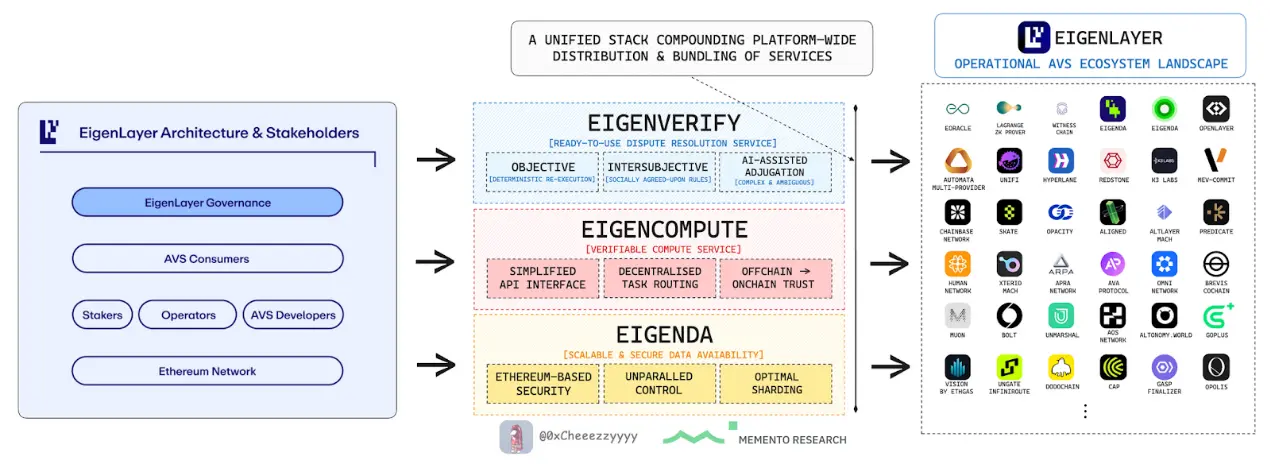
Complete architecture stack of Eigenlayer
EigenCloud is not just a collection of primitives; it is a coherent underlying architecture for verifiability. Each core module is designed to address key bottlenecks in the verifiability lifecycle. Yet, all modules achieve native interoperability within the same framework:
- EigenDA (Data Availability): Provides persistent, high-throughput storage for inputs and outputs, supporting independent re-execution and transparent audit trails. Immutable commitments form the basis for repeatability and contestability.
- EigenVerify (Dispute Resolution): Offers dispute resolution as a service, including objective re-execution, intersubjective consensus, and even AI-assisted adjudication. All outcomes support recourse, ensuring disputes can ultimately be resolved with economic binding.
- EigenCompute (Verifiable Off-Chain Computation): Acts as a verifiable container orchestration layer, where workloads are executed under deterministic wrappers. Security is measured per operation, and third-party AVS can be composed through a streamlined, developer-friendly interface.
These modules converge into a platform layer for programmable verifiability. EigenCloud unifies these disparate primitives into a flexible cloud-native capability that can be directly embedded into existing systems, allowing developers to avoid piecing them together.
Implicit Bundling
Given the design and structural foundation of EigenCloud, its significant advantage lies in implicit bundling. By unifying data availability, dispute resolution, and verifiable computation within a single stack, EigenCloud provides a default seamless end-to-end verification workflow. This means developers no longer need to manually piece together isolated primitives or manage fragile integrations. Each module naturally connects to the next: data is submitted, claims are anchored, challenges can be raised, and disputes are resolved—all within a coherent process.
As a result, external applications can flexibly integrate any or all modules of EigenCloud according to their needs while still benefiting from the assurances of the entire stack. Implicit bundling transforms verifiability from a fragmented practice into a cloud-native feature that is easy to adopt and powerful enough to support mission-critical operations.
Highly Compatible Developer Ecosystem
Moreover, EigenCloud is not designed solely for cryptographers or protocol engineers. It aims for maximum inclusivity. By lowering integration barriers, EigenCloud enables developers in Web3, enterprise, and artificial intelligence to embed cryptoeconomic trust where it is most needed.
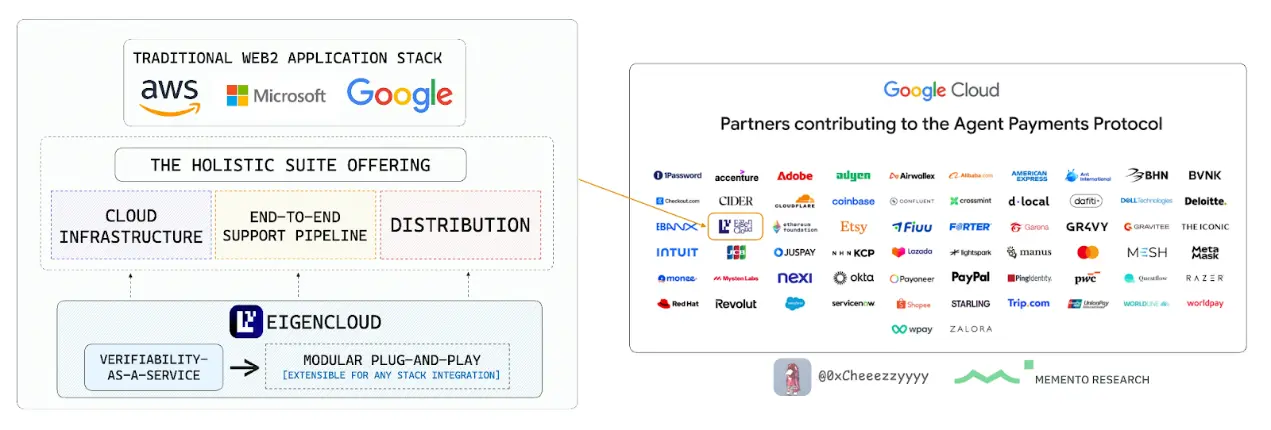
Its value proposition is twofold:
- Simplified end-to-end integration for Web3 developers: EigenCloud provides an end-to-end integration path that minimizes learning costs. Developers can directly access verifiability primitives without needing to re-architect their stacks. The AVS DevKit, composable middleware, and orchestration tools all come with built-in monitoring and development tools.
- Modular and scalable, suitable for any tech stack: For non-crypto applications, EigenCloud offers modular plug-and-play components. Teams can selectively integrate verifiability in any form within their native tech stack without a complete migration. This approach aims to democratize cryptographic-level trust in traditional and native AI environments while maintaining architectural flexibility.
This inclusivity is further strengthened by strategic partnerships. Google's new Agent Payment Protocol (AP2) marks a significant step forward for AI agents as meaningful economic participants. EigenCloud provides the infrastructure for verifiability, ensuring these agents are accountable to any counterpart by embedding VaaS into broader distribution channels and workflows.
By combining these two paths, EigenCloud has become a universal foundation for verifiability: it is user-friendly for Web3 native applications and equally attractive for enterprises, AI developers, and traditional software builders.
Closed Loop: Practical Implementation of Programmable Verifiability
By combining modular primitives with implicit bundling, EigenCloud transforms verification from a fragmented ideal into a practical and scalable service layer, where complex assurance processes are simplified into a single developer workflow, and trust is composable, programmable, and monetizable across various domains. Thus, EigenCloud is not just an infrastructure innovation; it is a gateway. By making verification accessible to all types of builders, it redefines the fundamental expectations of digital infrastructure: that outcomes are guaranteed by proof rather than promises.
Distribution, Coordination, and Flywheel
What solidifies its structural lead is not only architectural innovation but also distribution, first-mover advantage, and the self-reinforcing network effects that accumulate over time.
At the center of this flywheel is $EIGEN, a native cryptoeconomic asset that coordinates the interests of stakers, operators, developers, and enterprises, while also representing the rise of programmable trust.
Differentiated Niche Markets and Distribution Advantages
EigenLayer is the first platform to pioneer shared security, formally establishing a new category of "Trust as a Service" and spawning the current $28.9 billion re-staking market.
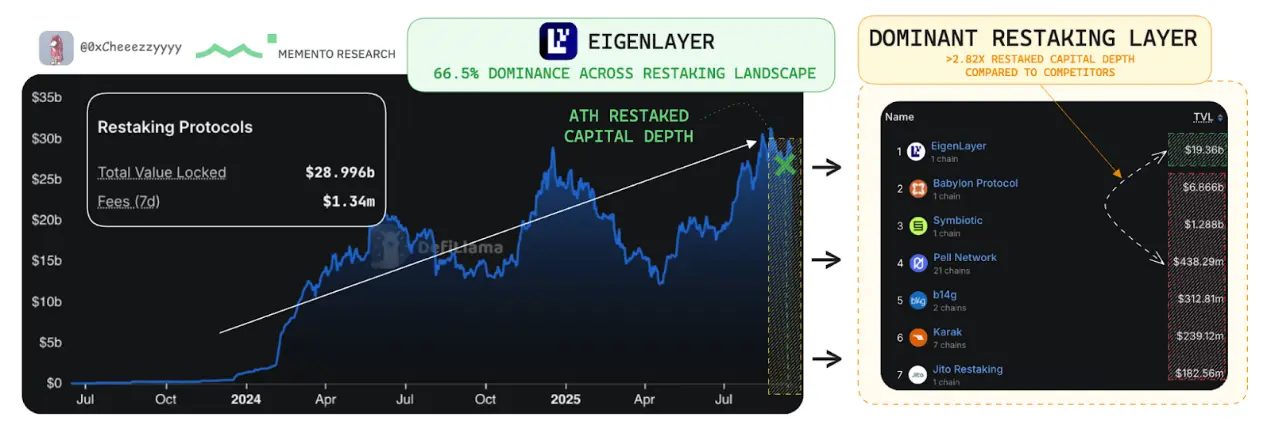
This early innovation not only brought novel application scenarios but also provided immediate integration pathways and funding access. EigenLayer holds approximately 66.5% of the re-staking market share, securing nearly $20 billion in Ethereum collateral across over 60 AVS ecosystems. This dominance is attributed to long-standing credibility, proven infrastructure, and deep ecological support.
Unique Dual Distribution Moat and Asymmetric Potential
EigenLayer's structural advantage lies in its unique dual moat.
- Security as a Service (SaaU): EigenLayer provides robust shared security infrastructure, formalizing ETH re-staking as a universal utility for AVS. This ensures that every new service inherits security depth without needing to rebuild trust from scratch.
- Verifiability as a Service (VaaS): EigenCloud extends this model by allowing applications to "rent" verifiability budgets between EigenDA, EigenVerify, and EigenCompute. This transforms cryptoeconomic assurances into a consumable service.
This dual distribution creates an asymmetric growth curve. Each new AVS (whether an oracle, bridge, reasoning engine, or compliance service) enriches the types and choices of verifiable workflows.
As developers build these services, time to market shortens, and adoption rates grow exponentially, positioning EigenCloud as the default backend platform for verifiable applications.
Flywheel of Network Effects
This dual foundation initiates two complementary flywheels: (1) security-driven adoption and (2) verifiability-driven distribution, both of which reinforce EigenLayer's dominance.
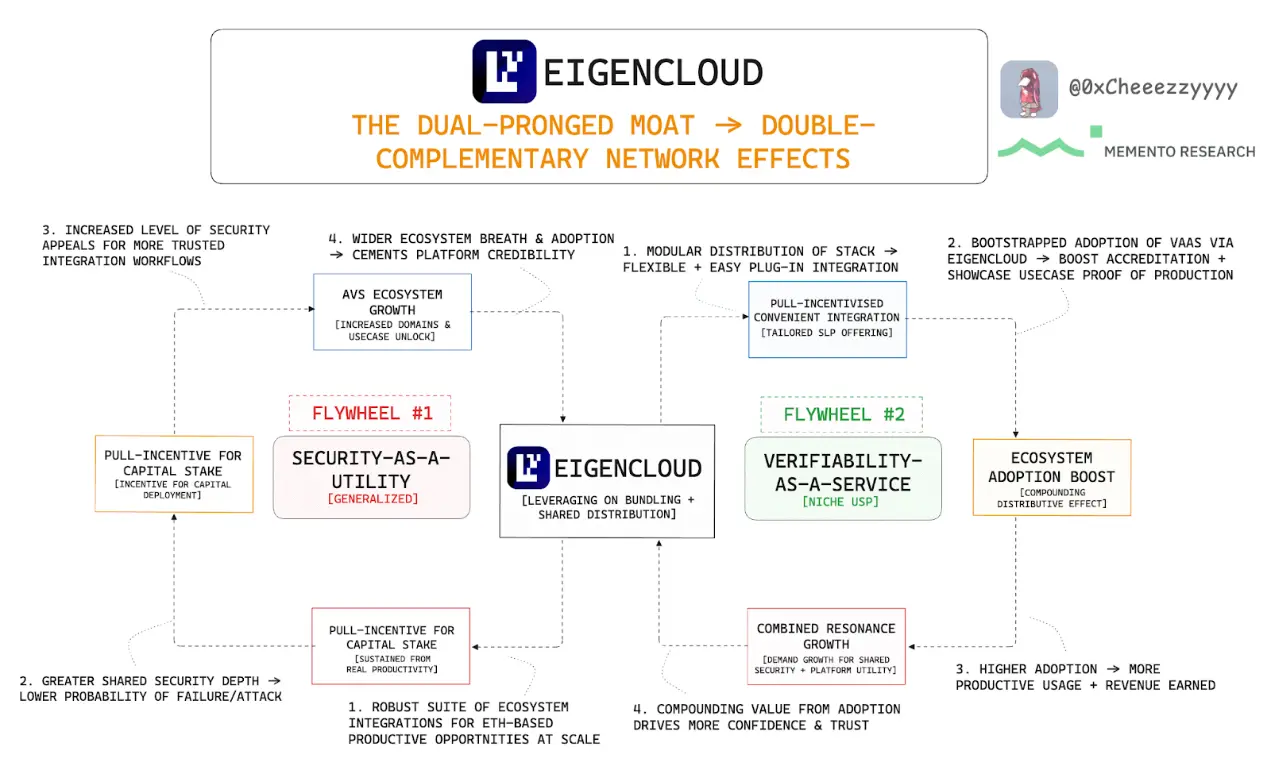
Flywheel One: Security-Driven Adoption
This is the core growth engine of EigenLayer:
- Re-staked funds → Shared security pool
When ETH is re-staked to EigenLayer, it flows into a security pool that any AVS can call upon. New services do not need to build their own validator sets or establish trust from scratch; they can immediately inherit Ethereum's credibility, positioning EigenLayer as a universal market where security itself becomes a ready-to-use utility.
- Reduced risk and cost → Pulling AVS integration
The deeper the security pool, the lower the probability of AVS being attacked or experiencing failures. This not only reduces economic risks but also lowers operational costs, making EigenLayer an attractive hub where new services naturally want to deploy. Developers are drawn to EigenLayer not because they do not have to compete for scarce validators, but because it minimizes burdens while providing Ethereum-level security.
- Expanded Functionality → More Applications and Liquidity
As more AVS join, they bring specialized functionalities that enhance the composability of the ecosystem. This broader toolkit attracts those who prefer to build applications and liquidity providers in the most resource-rich and diverse infrastructure environments, amplifying EigenLayer's role as a center of innovation.
- Stronger Operator Economics → More Stakers → Higher Security
Each new application joining the ecosystem generates transaction fees and rewards, thereby enhancing the economic benefits for operators. Higher yields attract more stakers, expanding the ETH security pool and further enhancing the platform's risk resilience. This creates a self-reinforcing cycle: adoption enhances security, and stronger security promotes adoption, solidifying EigenLayer's position as a shared security layer.
Flywheel Two: Verifiability-Driven Distribution
Based on this security foundation, EigenCloud drives a second reinforcing flywheel. By bundling verifiability into applications and leveraging EigenLayer's existing network state, it accelerates distribution while enhancing the certification of applications beyond DeFi.
- Modular Distribution → Rapid Adoption
EigenStack and EigenCloud allow projects to tap into Ethereum's validator base and existing distribution channels, avoiding cold start issues. Applications can scale immediately by leveraging verified infrastructure without slowly building trust and usage.
- Bundling Effect → Certified Trust
By embedding EigenCloud's verifiability into application states, projects inherit credibility from Ethereum's validation layer and the trust it has gained globally. This bundling makes it easier for enterprises, institutions, and regulators to integrate without needing a separate track record for each new service.
- Accelerated Integration → Composite Adoption
Every new integration of the EigenCloud stack enhances the ecosystem's attractiveness and credibility. As developers, enterprises, and institutions gather around a universal validation layer, adoption rates continuously increase, creating momentum for network growth.
- Metcalfe Resonance → Consolidation Beyond DeFi
As the adoption rate of more services increases, EigenLayer's network effects resemble Metcalfe's Law, where value grows exponentially with each new integration. This not only positions EigenLayer as the most powerful shared security layer but also builds its bundled capability for universal programmable verifiability.
Synergistic Integration
These two flywheels intertwine, driving exponential growth: re-staked ETH supports shared security, attracting AVS and applications; while EigenCloud accelerates verifiability and distribution in new markets. Scalable security makes applications feasible, and scalable verifiability makes them trustworthy. Together, they form a dual-pronged system where each cycle reinforces the other.
$EIGEN: Value Capture of the Ecosystem
At the core of EigenCloud is the verifiability token $EIGEN. It solidifies the system by protecting AVS, supporting dispute resolution, and monetizing programmable verifiability. Unlike utility tokens tied to specific use cases, $EIGEN represents ownership of the entire verifiability economy—covering data availability, dispute resolution, and verifiable computation.
Platform Positioning and Scale
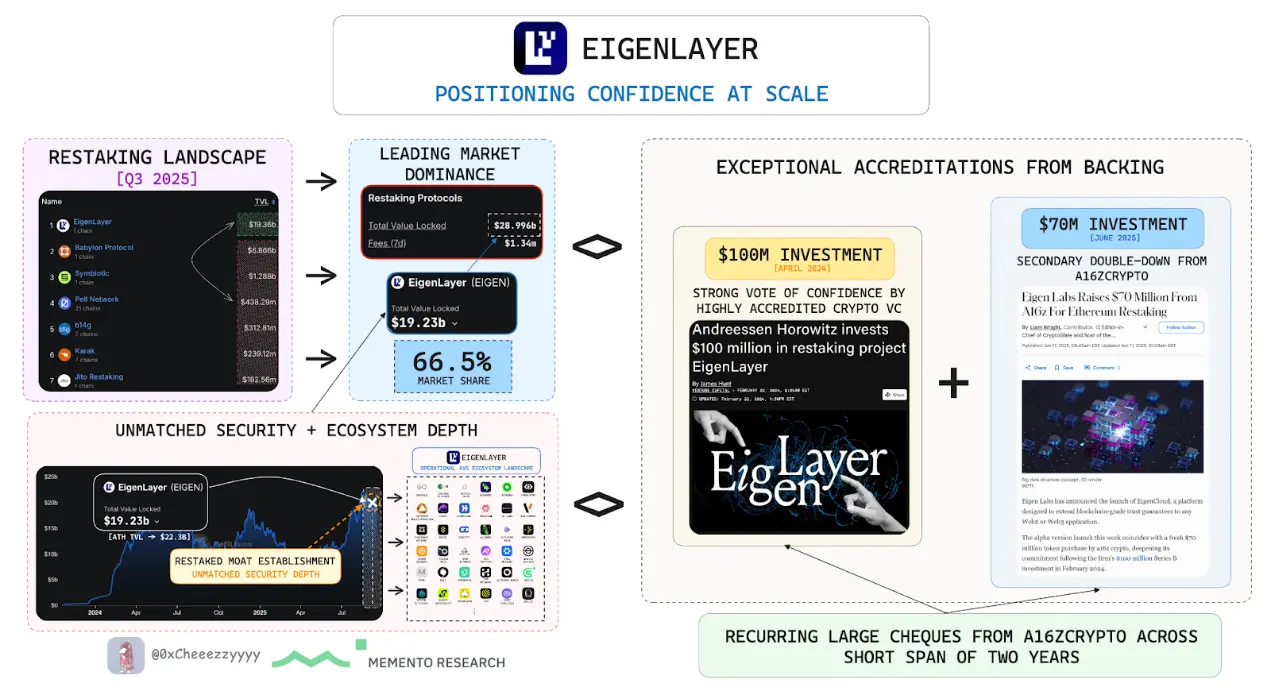
EigenLayer's dominance in the shared security space lays the foundation for $EIGEN within the industry, and its position is further strengthened by platform-wide certifications:
- Security and Ecosystem Depth: Approximately $20 billion in ETH re-staking ensures network security and integrates over 60 active AVS, with continuous growth.
- Industry Dominance: Holds 66.5% market share in the re-staking sector.
- Certifications and Investor Support: Secured $70 million in funding from a16z, along with recognition from industry leaders.
Value Accumulation: Compound Flywheel Effect
On this foundation, $EIGEN continuously accumulates value through a self-reinforcing cycle. More staking expands the cryptoeconomic security pool, making EigenCloud services cheaper and more reliable.
Lower costs attract more applications (covering DeFi, AI, and enterprise workflows), which embed verifiability into mission-critical operations. As usage grows, fees compound, generating a lasting revenue stream that improves operators' economic benefits and incentivizes more staking inflow.
Each cycle reinforces the next: deeper staking leads to cheaper services, cheaper services attract more applications, applications drive usage, increased usage raises fees, and fees ultimately attract more capital. Over time, this dynamic mechanism solidifies $EIGEN's position as the economic pillar of EigenCloud.
Multifaceted Value Accumulation for Stakeholders
Undoubtedly, the design of $EIGEN is central to the entire ecosystem, aiming to balance and satisfy the interests of all participants.
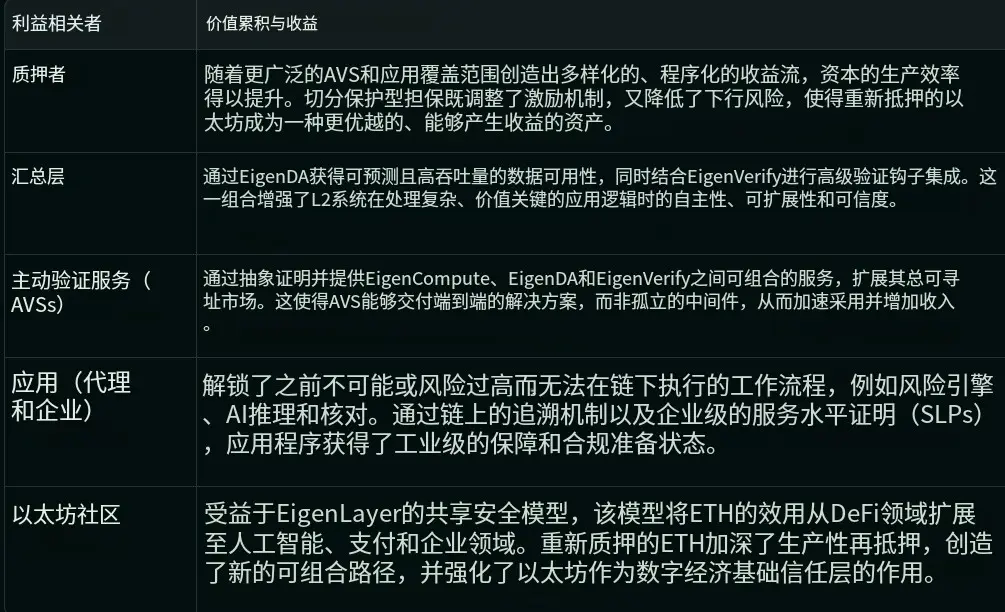
The interests of these stakeholders collectively reflect how EigenCloud transforms verifiability into a shared economic product rather than an isolated feature. Through inclusive incentive mechanisms, the network ensures that value flows in multiple directions while reinforcing the same foundation of cryptoeconomic security. This growth not only expands EigenCloud's adoption but also enhances its defensibility.
Balanced Perspective: Uncertainty and Risk
While structural advantages are evident, EigenCloud must also address a range of risks that could impact long-term adoption and defensibility.
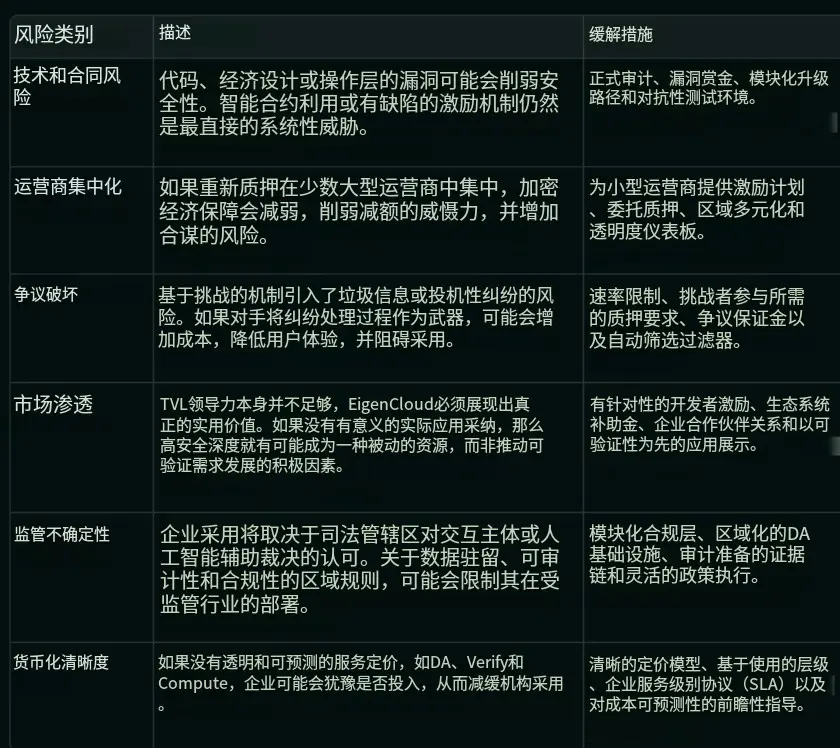
Technical risks, centralization pressures, and regulatory complexities are structural challenges that any network must confront and may affect its adoption trajectory.
However, these risks are not fatal flaws but rather obstacles to be overcome. For EigenCloud, the key test lies in its ability to balance decentralization with institutional demands, proving that the same architecture that unlocks programmable verifiability can also adapt to the operational and regulatory realities of global deployment.
Conclusion
EigenCloud redefines decentralized infrastructure by prioritizing verifiability as a core principle. Beyond shared security, it extends to programmable, application-centric verifiability, addressing the urgent needs of artificial intelligence, enterprises, and global coordination systems. EigenCloud transforms verifiability from a fragmented ideal into a composable, developer-centric platform.
This establishes a unique dual complementary moat for its SaaU and VaaS, making EigenCloud the default trust layer. By setting new industry standards for service-level proof, it achieves widespread adoption in the fields of artificial intelligence, enterprise, and capital markets.
At the center of this flywheel is $EIGEN, the foundational asset of a multi-trillion-dollar verifiability economy and a pillar for future high-risk digital infrastructure.
Related Reading: Verifiable Cloud EigenCloud: A New Paradigm for the Integration of Web2 and Web3
免责声明:本文章仅代表作者个人观点,不代表本平台的立场和观点。本文章仅供信息分享,不构成对任何人的任何投资建议。用户与作者之间的任何争议,与本平台无关。如网页中刊载的文章或图片涉及侵权,请提供相关的权利证明和身份证明发送邮件到support@aicoin.com,本平台相关工作人员将会进行核查。




